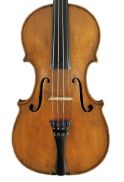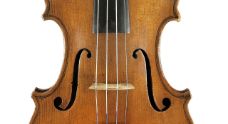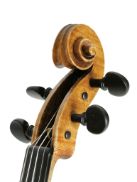Violin, Giovanni Battista Guadagnini, Turin, 1774, “Mantegazza”
Printed label: “Joannes Baptista Guadagnini / Cremonensis fecit Taurini. 1774 [initials GBG T]” (1774 handwritten)In the course of his remarkable career, Guadagnini worked in several cities in Northern Italy, arriving at his last destination, Turin, in 1771. This is where the luthier became acquainted with Count Cozio di Salabue, a passionate violin collector and researcher who had purchased the workshop tools and instruments from Stradivari’s descendants. He gave Guadagnini access to these workshop contents and entered into a contract of several years with him in December 1773 on the delivery of 50 newly made instruments. This violin dated 1774 is also thought to have been covered by the agreement. The instrument is typical of Guadagnini’s late work. Like the violin from 1770–1775, its f-hole notches are positioned very low. Its two-piece belly has very wide annual rings and a slight hazel figure. According to a dendrochronological report, the two halves of the belly are not from the same log. The youngest tree ring is dated 1767. The divided maple back shows tight, horizontal flames. The ribs and head are also tightly flamed with a very appealing figure. Thanks to its exceptionally fine state of preservation, the edgework and purfling details of this instrument are easy to see. This instrument still has the original neck, which, however, was reset at the neck root to increase the neck angle and thus the neck stop. The golden-yellow varnish with a red tint is very well preserved; it is not typical of Guadagnini’s varnishes. There are many indications that the varnish of this violin was applied later and not by Guadagnini. After the relationship between Guadagnini and Count Cozio had cooled off around 1780 as a result of financial controversies, Count Cozio commissioned the Mantegazza brothers with repairs of instruments from his collection. It is assumed today that Guadagnini delivered the 1774 violin unvarnished and that Mantegazza applied the varnish subsequently. Mantegazza may also have been responsible for the modification of the neck. The few signs of use of the instrument and the details of its history, which can be reconstructed from indirect evidence, contribute to the value of this extraordinary violin. A certificate issued by W. E. Hill & Sons in 1902 describes the instrument as a “characteristic and perfectly preserved specimen.” The certificate was made out for Sir Felix Otto Schuster, who was born in Frankfurt in 1854 and who later settled in London, where he held top positions as a banker.






